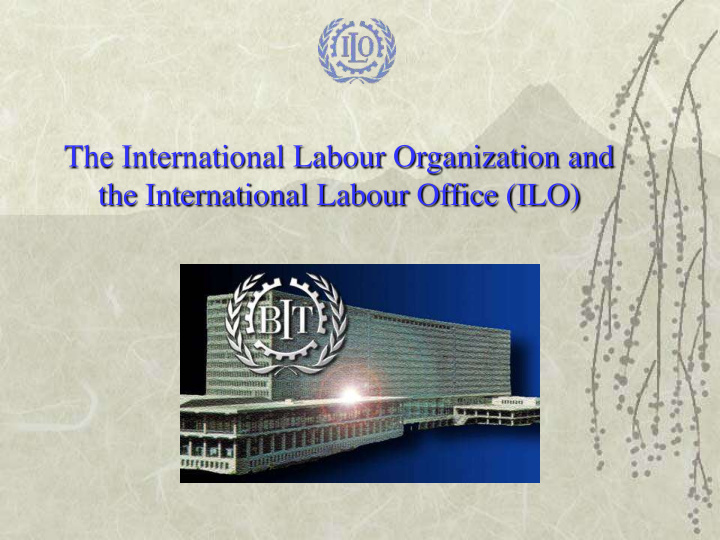



The International Labour Organization and the International Labour Office (ILO)
Some history Established in 1919, after World War I 181 Member States Tripartite structure – Employers – Workers – Governments Part of the United Nations system Based in Geneva, Switzerland
Our Director-General Juan Somavía
The problem of OSH Just on fatalities: there were an estimated 1.9 – 2.3 million work-related deaths in 2000: 18% 17% 0.4% 1% 1% 32% 23% 8% Communicable diseases Cancer Respiratory Diseases Circulatory diseases Mental Disorders Digestive systems diseases Genitourinary system Accidents and violence
Competitivity and safety Sources: World Economic Forum; ILO/SafeWork Rank 60 50 Competitiveness (World Economic Forum) 40 30 20 10 Fatal accidents/100 000 workers 0 Finland USA Korea R. Australia UK Canada Belgium Japan Norway South Africa Spain Hungary Brazil Portugal Malaysia Thailand China Russia Germany Switzerland Sweden France Ireland Chile Mexico Indonesia Netherlands
The ILO response Standards Research Information Advocacy
ILO instruments on OSH Relevant standards – 35 Conventions (including the Promotional Framework for Occupational Safety and Health Convention, 2006 ) – 3 Protocols – 27 Recommendations Other relevant instruments – 46 Codes of Practice
Other principal ILO Instruments concerning OSH Recommendation R194 concerning the List of Occupational Diseases and the Recording and Notification of Occupational Accidents and Diseases Recommendation (2002). The Occupational Safety and Health Convention C155 and its accompanying Recommendation R164 and Protocol (1981). This is considered as the basic OSH convention of the ILO. The Occupational Health Services Convention C161 and its accompanying Recommendation R171 (1985). The Working Environment (Air Pollution, Noise and Vibration) Convention C148 and its accompanying Recommendation R156 (1977).
Codes of Practice published by the ILO
International Occupational Safety and Health Information Centre (CIS) Centre international d’informations de sécurité et de santé au travail (CIS) CIS is the safety and health information centre of the ILO. It was established in 1959 with the aim of collecting all relevant information about occupational safety and health (OSH) being published around the world, whatever the format and the language, and to diffuse this information to OSH professionals and others concerned by safety and health matters around the world.
CIS Abstracts CIS 07-544 New approaches to integrated occupational safety and health and environmental protection. ( German: Neue Wege zum integrierten Arbeits- und Umweltschutz) Bieneck H.J., Sicherheitsingenieur , 2006, Vol.37, No.7, p.12-15. (In German) The ties between occupational safety and health and environmental protection have always been close ones. For example, risk evaluations of chemical substances in the European Union include the study of their effects on health and the environment. In many companies, safety officers need to cooperate with those in charge of environmental concerns. Increasingly, more companies integrate occupational safety and health as well as environmental protection into the company management system because studies confirm that staff, company and society benefit from such integrated management systems. Sustainable protection measures which go beyond legal requirements are increasingly selected in companies and examples of such good practices are being published in the hope that these integrated approaches to occupational safety and health and environmental protection will quickly spread to a large number of companies. (106693)
The ILO Encyclopaedia of Occupational Health and Safety http://www.ilo.org/encyclopaedia/
Some figures... 100 chapters 1000 articles 1000 illustrations 2500 references more than 1000 authors more than 3500 pages ... and an enormous index!
The CIS Network of National, Collaborating and Regional Centres 1959 11 centres 2007 140 centres
The CIS Centres – What they are Non-gov. Academic Inspectorate Other Gov. Social Security Health Genl. Health Inst. Labour Inst. Labour Genl.
The CIS Centres – Where they are Africa Americas E. Asia-Pacific Europe W. Asia S. Asia
Thank you for your attention http://www.ilo.org/cis
Recommend
More recommend